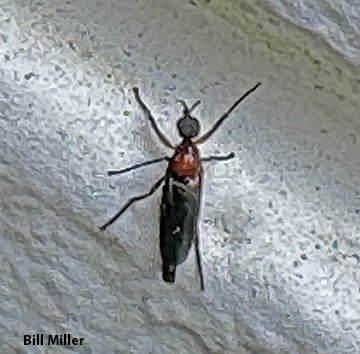
Large eyes of the male March fly provide excellent vision for chasing competitors and selecting mates.

This little male March fly piqued the interest of a nature enthusiast and inspired this episode. Image: Bill Miller
A couple weeks ago, a bug aficionado inquired about an unusual, largish fly in his yard. This stranger was none other than a March fly, a member of the bibionid clan some 700 species strong. A few seasons back on a welcomed warm afternoon in April, swarms of March flies bobbed and weaved over the lawn in my backyard. In many parts of the land, March flies seem not to get the email and make their appearance in April or May rather than March, creating an interesting misnomer for these small flies. As a family of insects, March flies include randy Lovebugs, a.k.a Honeymoon bugs, so named for their behavior of remaining intwined in conjugal bliss for long periods of time. Adult flies do not bite or sting, but vast numbers emerging in spring and again in fall are a real nuisance to residents in some of our southern states. In addition to entering homes and bumbling about in the garden, Lovebugs splatter windshields of cars and trucks creating hazardous driving conditions. In some locations they become so numerous that they can clog radiators of cars.
Since last growing season, March fly larvae have been consuming organic matter in the soil beneath my lawn. These tiny maggots are recyclers helping unlock the nutrients in decomposing plants and returning them to the food web that is my backyard. In late spring they complete development and form pupae which, with the warmth of spring weather, mature as acrobatic flies that emerge from the earth and perform over my zoysia grass. The aerial ballet of March flies consists mostly of males jockeying for position to capture a mate as female March flies emerge from the turf. One fascinating study of male swarming behavior discovered that larger males often occupied flight space nearer the ground where they chased other smaller males away - all the better to intercept nubile females as they rise from the earth. After mating, females return to the soil and lay more than 100 eggs to complete the circle of life.
On warm afternoons in March, April, and May swarms of March flies perform aerial acrobatics over the lawn. It’s all part of the mating game. A big-eyed male rests on a blade of grass before taking off to find a mate. And in southern states it’s easy to see why these flies carry the handle of Lovebugs and Honeymoon bugs. As larvae, they recycle organic matter in the soil while adults help keep our world green by pollinating plants.

March flies like this little beauty help pollinate spring blooming trees and shrubs.
Bobbing, weaving, chasing other males, and intercepting females in flight are facilitated by the large complex eyes of the males. These bulbous eyes are actually divided into dorsal and ventral visual systems with the dorsal eyes gathering information from above and the ventral eyes watching what lies below – truly a case of four eyes. However, clever photographic analysis has shown that the dorsal eyes are the ones used to gage pursuit of other March flies and to differentiate potential mates from potential competing suitors. In addition to being highly entertaining as they swarm in my yard, many March flies are important pollinators of spring blooming plants. Each spring my large holly tree gives forth with blossoms that March flies and a wild menagerie of bees, wasps, and other pollinators find irresistible.
Acknowledgements
The interesting article “Sexual Dimorphism in the Visual System of Flies: The Free Flight Behaviour of Male Bibionidae (Diptera)” by Jochen Zeil was used as a reference for this episode. We thank Bill Miller for sharing his nice image of a March fly, which inspired this episode.
No comments:
Post a Comment